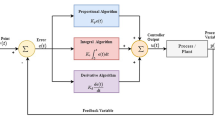Abstract
Industrial processes are multi input multi output, non-linear, and constrained in nature. The sensors, data acquisition systems, controller and the actuators of the above said processes are all networked to form as networked control system with various network constraints. Other issues in the smart measurement sensor non-linearity, uncertainty and noises. The PID and MPC are the famous industrial controller for controlling the above processes. PID controller is popular due to its simplicity in tuning parameter and the MPC is preferred for its superior control performance. However, in process industries, the MPC based controller is used in the supervisory level which gives the command signal to the regulatory level PID controller. This PID controller is used for controlling the industrial process which makes limited MPC performance. It makes challenges to the researcher to develop next generation controller which can able to address the above stated problems. This enhances the research scope in the domain of SMART process measurement and automation. There arises a necessity to come up with a solution for the above problems which has industrial acceptability, simplicity, flexibility and scalability. This research paper is aimed to bring into sight the various research challenges involved in smart process measurement and automation and solution to some of the same.





Similar content being viewed by others
References
Galán O, Romagnoli JA, Palazoglu A (2004) Real-time implementation of multi-linear model-based control strategies—an application to a bench-scale pH neutralization reactor. J Process Control 14(5):571–579. https://doi.org/10.1016/j.jprocont.2003.10.003
de Oliveira Nuno MC, Biegler LT (1994) Constraint handling and stability properties of model-predictive control. Am Inst Chem Eng J 40(7):1138–1155
Zhang L, Gao H, Kaynak O (2013) Network-induced constraints in networked control systems-a survey. IEEE Trans Ind Inform 9:403–416. https://doi.org/10.1109/TII.2012.2219540
Zahmati AS, Fernando X, Kojori H (2011) Transmission delay in wireless sensing, command and control applications for aircraft. In: 4th Annual Caneus fly-by-wireless work. FBW vol 11, pp 91–94. https://doi.org/10.1109/fbw.2011.5965563
Zhang D, Shi P, Wang QG, Yu L (2017) Analysis and synthesis of networked control systems: a survey of recent advances and challenges. ISA Trans 66:376–392. https://doi.org/10.1016/j.isatra.2016.09.026
Ge M, Chiu M-S, Wang Q-G (2002) Robust PID controller design via LMI approach. J Process Control 2(1):3–13. https://doi.org/10.1016/S0959-1524(00)00057-3
Huang HP, Jeng JC, Chiang CH, Pan W (2003) A direct method for multi-loop PI/PID controller design. J Process Control 13(8):769–786. https://doi.org/10.1016/0959-1524(03)00009-X
Morley A, Derrick J, Mainland P, Lee BB, Short TG (2000) Closed loop control of anaesthesia: an assessment of the bispectral index as the target of control. Anaesthesia 55(10):953–959
Cao N, Lynch AF (2016) Inner-outer loop control for quadrotor UAVs with input and state constraints. IEEE Trans Control Syst Technol 24(5):1797–1804. https://doi.org/10.1109/TCST.2015.2505642
Qin SJ, Badgwell TA (2003) A survey of industrial model predictive control technology. Control Eng Pract 11(7):733–764. https://doi.org/10.1016/S0967-0661
Ferramosca A, Limon D, Alvarado I, Camachoa EF (2013) Cooperative distributed MPC for tracking. J Autom 49(4):906–914. https://doi.org/10.1016/j.automatica.2013.01.019
Ding T, Bo R, Li F, Gu Y, Guo Q, Sun H (2015) Exact penalty function based constraint relaxation method for optimal power flow considering wind generation uncertainty. IEEE Trans Power Syst 30(3):1546–1547. https://doi.org/10.1109/TPWRS.2014.2341177
Ogunnaike BA, Mukati K (2006) An alternative structure for next generation regulatory controllers. Part i: basic theory for design, development and implementation. J Process Control 6(5):499–509. https://doi.org/10.1016/j.jprocont.2005.08.001
Yelneedi S, Woon YT, Rangaiah GP, Samavedham L (2009) A comprehensive evaluation of pid, cascade, model-predictive, and RTDA controllers for regulation of hypnosis. IndEngChem Res 48(2009):5719–5730. https://doi.org/10.1021/ie800927u
Srinivasan Kand Anbarasan K (2013) Fuzzy scheduled RTDA controller design. ISA Trans 52(2):252–267. https://doi.org/10.1016/j.isatra.2012.11.008
Sendjaja AY, Ng ZF, How SS, Kariwala V (2011) Analysis and tuning of RTD-A controllers. Ind Eng Chem Res 50(6):3415–3425. https://doi.org/10.1021/ie102154y
Mukati K, Rasch M, Ogunnaike BA (2009) An alternative structure for next generation regulatory controllers. Part ii: stability analysis, tuning rules and experimental validation. J Process Control 19(2):272–287. https://doi.org/10.1016/j.jprocont.2008.03.004
Anbarasan K, Srinivasan K (2015) Design of RTDA controller for industrial process using SOPDT model with minimum or non-minimum zero. ISA Trans 57:231–244. https://doi.org/10.1016/j.isatra.2015.02.016
Diamond JM (1970) Linearization of resistance thermometers and other transducers. Rev Sci Instrum 41(1):53–60. https://doi.org/10.1063/1.1684279
Patra J, Kot AC, Panda G (2000) An intelligent pressure sensor using neural networks. IEEE Trans Instrum Meas 49(4):829–834. https://doi.org/10.1109/19.863933
Patra JC, Ang EL, Meher PK (2006) A Novel neural network-based linearization and auto-compensation technique for sensors. In: IEEE-ISCAS pp 1167–1170. https://doi.org/10.1109/ISCAS.2006.1692798
Sun S, Xie L, Xiao W, Soh YK (2008) Optimal linear estimation for systems with multiple packet dropouts. Automatica 44:1333–1342. https://doi.org/10.1016/j.automatica.2007.09.023
Haseena BA, Srinivasan K (2018) Development of mixed constrained RTDA controller for industrial applications. ISA Trans 81:197–209. https://doi.org/10.1016/j.isatra.2018.07.005
Sarawade PD, Srinivasan K (2018) T-S fuzzy-based multi-LAE approach for sensor linearization. IET Sci Meas Technol 12(8):1015–1022. https://doi.org/10.1049/iet-smt.2018.5228
Roy AK, Srinivasan K (2017) Stochastic output feedback controller for two tank interacting nonlinear system. In: International conference IEEE INDICON, IIT Roorkee, pp 1–6. https://doi.org/10.1109/INDICON.2017.8487242
Sarawade PD, Srinivasan K (2018) Thermocouple linearization using data driven approach. In: 4th national conference on recent trends in instrumentation and control RTIC, pp 1015–1022. https://doi.org/10.1049/iet-smt.2018.5228
Acknowledgements
This publication is an outcome of the R&D work undertaken in the project under the Visvesvaraya Ph.D. scheme of Ministry of Electronics and Information Technology, Government of India, being implemented by the Digital India Corporation (formerly Media Lab Asia).
Author information
Authors and Affiliations
Corresponding author
Rights and permissions
About this article
Cite this article
Kannan, S. Smart process measurement and automation: challenges, solution and future direction. CSIT 7, 93–98 (2019). https://doi.org/10.1007/s40012-019-00238-7
Received:
Accepted:
Published:
Issue Date:
DOI: https://doi.org/10.1007/s40012-019-00238-7




